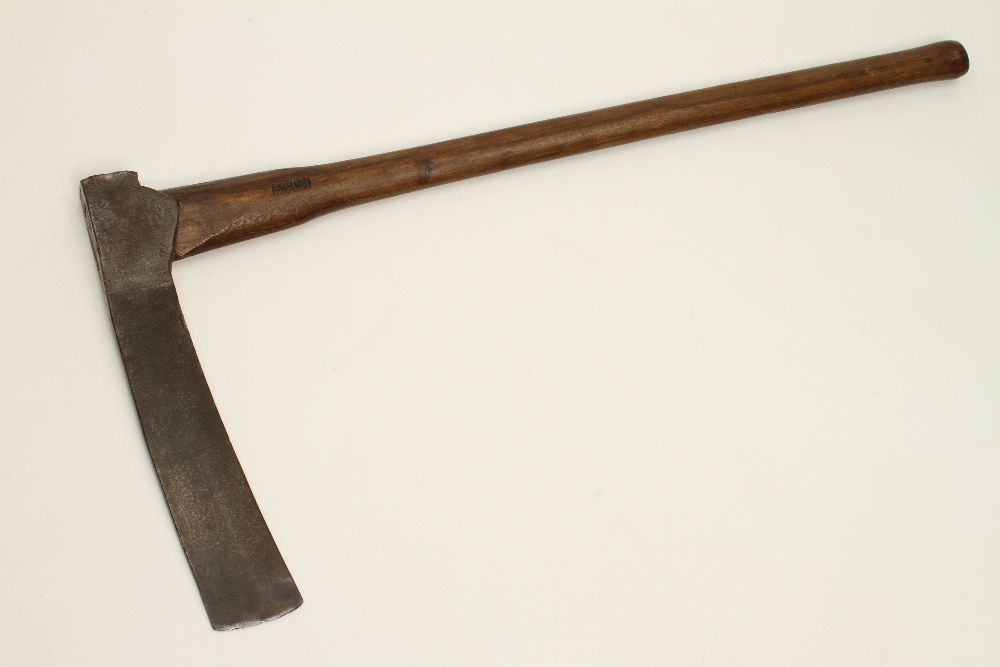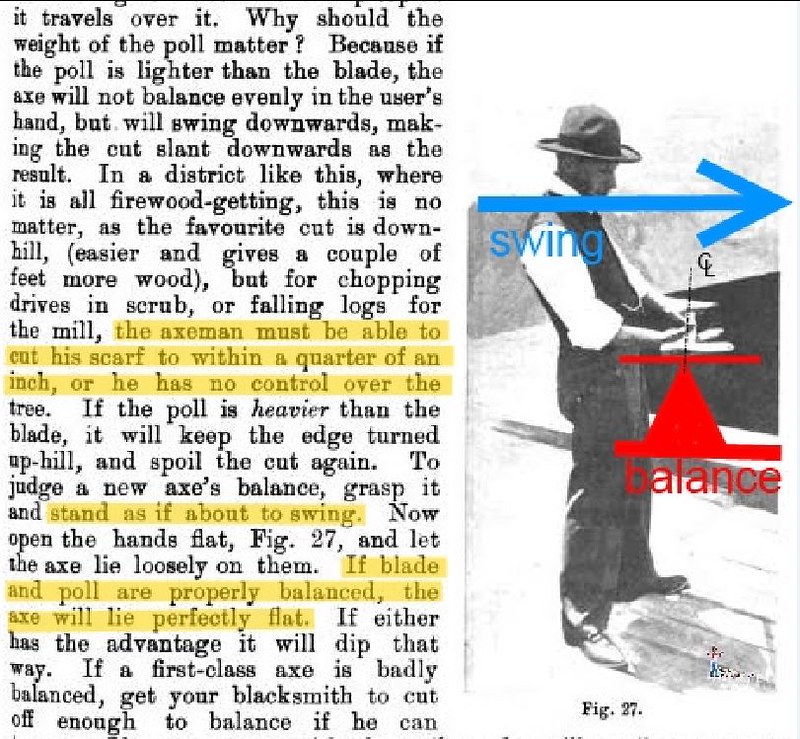...To get beyond any appearance of speculation and conjecture, can you give some specific examples that demonstrate the following claim:
The desire to tilt forward or back is significant (not negligible, not insignificant).
...
Like this very deep English felling axe (or so the originating website calls it) on a straight handle.
...The front/back thing will always be pretty insignificant except in the heaviest axes and even then you're not holding it there long. It's more of the triangulation thing that can start causing issues when you have deep bits on handles that aren't offset to at least
minimize triangulation if not fully eliminate it.
....
Please keep in mind that the following is meant as
constructive criticism.
Your response is still largely speculation or conjecture. (If you would argue that it's not speculation or conjecture, then for starters can you tell me how you determine whether the "desire to tilt forward" is negligible or non-negligible? What quantitative values do you have for this "desire to tilt forward" for the different cases you present, what values are negligible, and at what point does it become non-negligible?)
This is not a critique of you (although presenting conjecture as fact could be criticised), it's more about the limitations of the concepts you present such as "axle" when applied to 2-dimensional motion, for example. You're using some Center of Gravity concepts where other concepts would do a much better job. This results in convoluted "explanations" such as:
"...The handle may be in the same position as before, but the tool is going to desire to pivot forwards because the axle is now rear of its prior position. Thus, the actual travel of the axle has been moved back by however many degrees. In adding the weight and yet holding the handle and edge positions constant you have essentially moved the axle backward but then pushed the tool forward again in order to retain the original edge position. If the user were to hold it in the same position as before they will have the axle sitting rear of where it was prior, and when it arrives at the target it will, again, have the axle rear of where it was prior."
There are better, and simpler, "tools" to use for describing what you want to describe. Here's a suggested approach, starting with the axe being held by one hand at the usual end of a straight handle:
-------------------
An axe is held with the handle making an angle α with the horizontal. What the hand feels has two parts: (1) the weight W of the axe pushing downward (in the direction of gravity), measured in pounds; and (2) a type of "torque" (more properly called a "moment") that's measured in foot-pounds. The "torque" is equal to the weight of the axe multiplied by the horizontal distance from the axe's center of gravity to the hand.
The weight of the axe stays the same no matter which position it's held, but the "torque" will vary. When the axe is held upright, with the center of gravity directly above the hand, the weight is felt but there is no "torque" (because the horizontal distance is zero). When the axe is held straight ahead and horizontal (with the center of gravity at the same level as the hand), the hand feels the weight W plus the "torque" (the weight W times the distance from hand to center of gravity, which I'll call H, the handle length). The "torque" is at its maximum when the axe is at this horizontal position, because the horizontal distance is at the maximum.
For example, for an axe where W = 4 pounds, and H = 36" (or 3 feet), when held as described, in the vertical position (90 degrees) the hand feels 4 pounds weight and zero torque, while in the horizontal position (0 degrees) the hand feels 4 pounds weight and 12 foot-pounds "torque" (since 4 times 3 is 12). Slowly moving the handle from upright 90 degrees to level 0 degrees, the hand feels the torque gradually increasing from 0 foot-pounds up to 12 foot-pounds.
It's relatively easy to calculate what the hand feels for any position that the axe is held (using some basic trigonometry), for any combination of Weight, Handle length, and center of gravity location. I made a quick spreadsheet this afternoon to do these calculations. For the purposes of this thread, with discussion of the effects of changing the location of the axe's center of gravity, I added a variable D for the distance the center of gravity is located from the handle (distance measured at a right-angle to the handle).
Now the effects of moving the center of gravity back one inch, or forward one inch, for example, can be determined, to remove the speculation and conjecture from such concepts as "the desire to tilt forward or back".
A quick example of some results:
W = 4 pounds
H = 36 inches
For the case where the straight handle axis is aligned with the center of gravity, the torque ranges from 12 ft-lbs (at 0 degrees) down to zero ft-lbs (at 90 degrees), but it's not a linear decrease:
Degrees----
Ft-Lbs
0----12.0
22----11.1
45----8.5
67----4.7
90----0.0
For the case where the center of gravity is moved 1 inch forward (toward the bit), the torque ranges from 12 ft-lbs (at 0 degrees) down to 0.3 ft-lbs (at 90 degrees):
Degrees----
Ft-Lbs
0----12.0
22----11.3
45----8.7
67----5.0
90----0.3
Comparing these two cases, the torque increases when the center of gravity is moved 1 inch forward (toward the bit), and the increase in torque ranges from zero (no difference at 0 degrees) up to 0.3 ft-lbs (at 90 degrees):
Degrees----
Increase in Ft-Lbs
0----0.0
22----0.1
45----0.2
67----0.3
90----0.33
With this method, we can quantitatively estimate (instead of just making educated guesses) for the effects of different locations of the center of gravity, etc. And the terminology and methods are the same as used by textbooks and other sources. I will gladly share the spreadsheet, or formulas, or run more cases, if there is interest in this.






